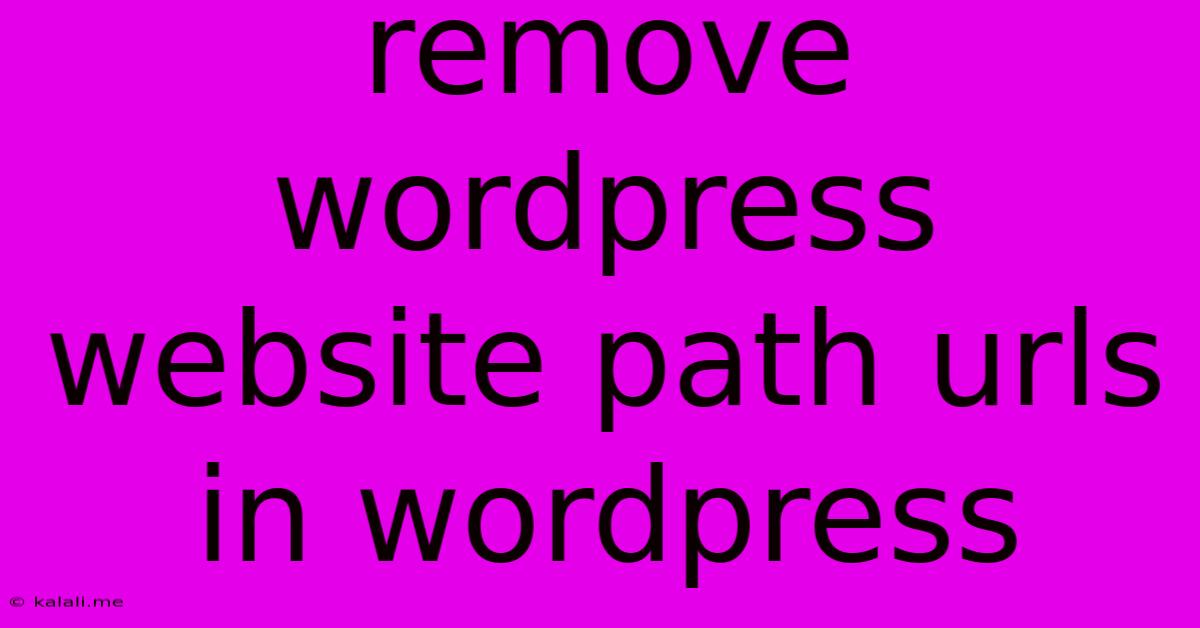Remove Wordpress Website Path Urls In Wordpress
Kalali
Jun 11, 2025 · 3 min read

Table of Contents
Remove WordPress Website Path URLs in WordPress: A Comprehensive Guide
WordPress often installs with a path in the URL, like yoursite.com/wordpress/. This can impact SEO and website aesthetics. This guide explains how to remove this unwanted path, ensuring clean, SEO-friendly URLs. We'll cover various methods, from simple plugin solutions to manual database edits, catering to different technical skill levels. Remember to always back up your website before making any significant changes.
Understanding WordPress Website Paths
A website path appears after your domain name in the URL. For instance, yoursite.com/wordpress/ shows a /wordpress/ path. This happens during installation, especially if WordPress isn't installed in the root directory of your hosting account. These paths can hinder SEO, making your site harder for search engines to crawl effectively, and also look unprofessional. Removing the path creates cleaner URLs like yoursite.com, improving user experience and search engine optimization.
Method 1: Using a Plugin (Easiest Method)
Several plugins simplify the process of removing the WordPress path. This is the recommended approach for beginners as it requires minimal technical knowledge. Search for plugins with names like "Remove WordPress Path" or "URL Path Fixer" within your WordPress dashboard. Once installed and activated, these plugins typically provide a simple interface to remove the path with a single click or setting change. Remember to check for plugin reviews and choose a reputable, well-maintained option.
Method 2: Manual Editing (For Experienced Users)
This method involves directly manipulating your WordPress database and configuration files. Proceed with caution, as incorrect edits can break your website. Before you begin, back up your entire website, including the database and files.
Steps:
-
Locate your
wp-config.phpfile: This is located in your WordPress root directory. -
Define
WP_HOMEandWP_SITEURL: Add these lines to yourwp-config.phpfile, replacingyoursite.comwith your actual domain name:define('WP_HOME','http://yoursite.com'); define('WP_SITEURL','http://yoursite.com'); -
Update the database: Access your database using phpMyAdmin or a similar tool. Locate the
wp_optionstable. Find the rows whereoption_nameishomeandsiteurl, and update theoption_valuecolumn to match your domain name (http://yoursite.com). -
Clear your browser cache and test: After making these changes, clear your browser cache and test your website to ensure everything functions correctly.
Method 3: Using .htaccess (Advanced Method)
This method involves modifying the .htaccess file. This is an advanced technique that requires a good understanding of .htaccess rules. Incorrect modifications can break your website, so proceed with extreme caution and back up your files.
You can potentially achieve path removal by adding or modifying rewrite rules within your .htaccess file. However, the effectiveness and required rules will greatly depend on your specific server configuration and existing rules. This method is less reliable than the previous ones, and it's generally recommended to try the other methods first.
Post-Removal Steps
After successfully removing the path, perform these essential checks:
- Test all links: Ensure all internal and external links are functioning correctly. Broken links can negatively affect SEO and user experience.
- Check your sitemap: Update your sitemap to reflect the URL changes. Submit the updated sitemap to Google Search Console.
- Monitor your website: Keep an eye on your website's performance and functionality after removing the path. Look for any unexpected errors or issues.
Conclusion
Removing the WordPress website path is crucial for creating a clean, professional, and SEO-friendly website. Choosing the right method depends on your comfort level with technical tasks. For most users, the plugin approach is the safest and easiest. Remember to always back up your website before making any changes to avoid potential problems. By following these steps, you can ensure your website has optimized URLs, improving its visibility and overall performance.
Latest Posts
Latest Posts
-
How To Find Perimeter Of A Cube
Jun 12, 2025
-
Gear Ratio Of A Compound Gear Train
Jun 12, 2025
-
How Many People On Volleyball Court
Jun 12, 2025
-
Which Of The Following Events Happened First
Jun 12, 2025
-
What Is A Union Of Independent Sovereign States
Jun 12, 2025
Related Post
Thank you for visiting our website which covers about Remove Wordpress Website Path Urls In Wordpress . We hope the information provided has been useful to you. Feel free to contact us if you have any questions or need further assistance. See you next time and don't miss to bookmark.